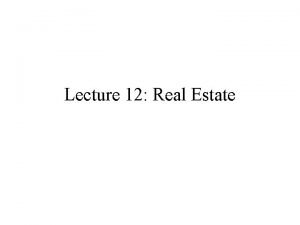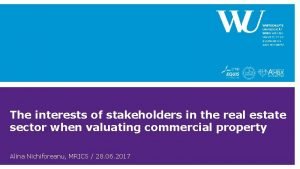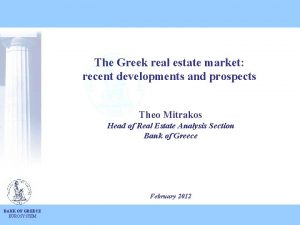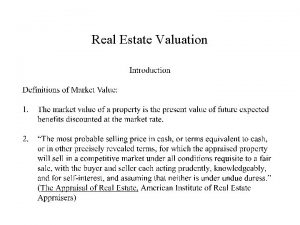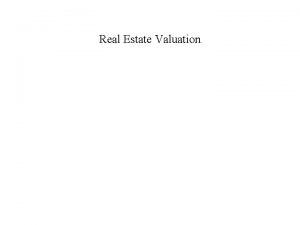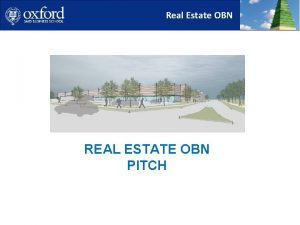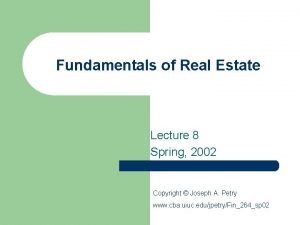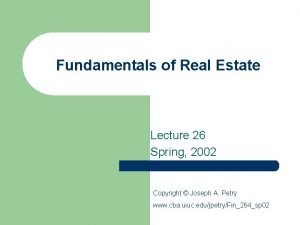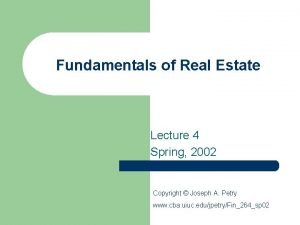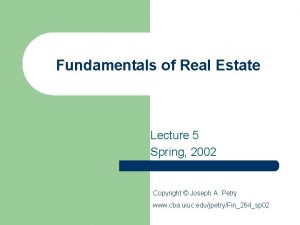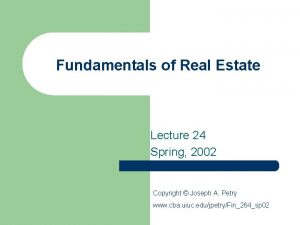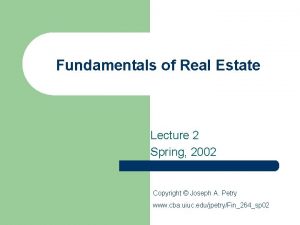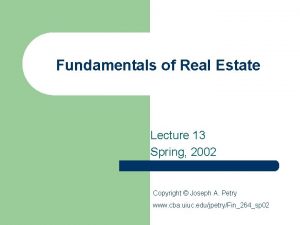Fundamentals of Real Estate Lecture 16 Spring 2002














- Slides: 14

Fundamentals of Real Estate Lecture 16 Spring, 2002 Copyright © Joseph A. Petry www. cba. uiuc. edu/jpetry/Fin_264_sp 02

Housekeeping Issues 2 Mid-term Exam #2 on Wednesday, March 13 th in class. l MC, 30 -40 questions, similar to homework, class examples. 2 questions from each presentation. l Exam will cover Ch. 8 -12. Chapter 12 until p. 309. Office hours: Monday, 4 -5, Tuesday 9: 00 -10: 45. Web-board questions checked Monday & Tuesday with all questions answered by 5: 00 pm each day. Homework for this week (today’s lecture—Chapter 12) has been posted. You should plan on completing this homework before the exam as the material will be covered. It is due no later than Friday, March 15 th.

Valuation by Sales Comparison & Cost Approaches—Chapter 12 Investment Value Vs. Market Value l l l Our earlier analysis identified what is the value to an individual investor of an income producing property. We aren’t always talking about income producing properties, and we often want value as set by “market”. Chapter 12, 13 overviews the role of “appraiser”. Role of Sales Comparison and Cost Approaches l The three general approaches to estimating market value are: – – 3 – Sales comparison approach Cost approach Income Capitalization approach

Valuation by Sales Comparison & Cost Approaches—Chapter 12 l The first two are what we cover in Chapter 12. – – – Generally used when property is not income producing. You will note as we do examples that we are not including any information about income potential of the properties involved. Used as secondary estimates of value for income producing properties. Multiple regression models likely to reduce demand in future for appraisals for typical, non-income producing properties. Traditional Sales Comparison Approach l l 4 Appraises value by comparing the “subject property” with similar properties which have sold recently. The sale prices of the “comparable properties” are adjusted to reflect any material differences w/ the subject property.

Valuation by Sales Comparison & Cost Approaches—Chapter 12 Steps in the Sales Comparison Approach 1. 2. 3. 5 Identify properties (comparable sales) that have sold recently that are comparable to the subject property. Adjust each comparable property’s sale price to account for its material differences from the subject property. This provides a “final adjusted price” for each comparable property. Reconcile the comparable properties’ final adjusted sales prices to determine a single indicated value.

Valuation by Sales Comparison & Cost Approaches—Chapter 12 Types of Adjustments – Appraisers must consider eight types of adjustments, divided into two categories: 1. Transactional characteristics: – – – 6 Conditions of sale. Were there any conditions of sale that were not typical of the market? (Note that only arm’s-length transactions should be used as comparables) Financing terms. Financed using below market or non-market financing? Market conditions. Has there been a significant change in the market since the comparable’s sale which have resulted in a change in the overall general price level?

Valuation by Sales Comparison & Cost Approaches—Chapter 12 7

Valuation by Sales Comparison & Cost Approaches—Chapter 12 Types of Adjustments 2. Property characteristics: – 8 Location. A comparable property’s sale price must be adjusted if the location is materially different from the subject property’s location.

Valuation by Sales Comparison & Cost Approaches—Chapter 12 Types of Adjustments 2. Property characteristics (cont’d): 1. 9 Physical Characteristics. A comparable property’s sale price must be adjusted if the physical characteristics are different from the subject property, and materially impact value.

Valuation by Sales Comparison & Cost Approaches—Chapter 12 Types of Adjustments 2. Property characteristics (cont’d): Legal characteristics. In theory, a comparable property’s price should be adjusted if any of the legal rights, materially affecting value, are different from those of the subject property. In practice, properties having legal characteristics different from the subject should not be used as comparable property sales. 2. Use. A comparable property’s sale price must be adjusted if the anticipated use is different from that of the subject property. 3. Nonrealty items. A comparable property’s sale price must be adjusted if any nonrealty (personal property) items, materially affecting value, were included in the sale price of the comparable property. 1. 10

Valuation by Sales Comparison & Cost Approaches—Chapter 12 Types and Sequence of Adjustments: – Adjustments may be made by subtracting or adding a specific dollar amount from the comparable property price, or by making a percentage adjustment to the appropriate price. Reconciliation: – In reconciling the final adjusted sale prices the appraiser may place more weight on one or more of the sales because he/she believes it is most representative of the subject property. This is generally determined by the number and size of the specific adjustments required. 11

12

Valuation by Sales Comparison & Cost Approaches—Chapter 12 Multiple Regression Models: Coefficients Random error varia y = b 0 + b 1 x 1+ b 2 x 2 + …+ bkxk + e Dependent variable 13 Independent variables

Valuation by Sales Comparison & Cost Approaches—Chapter 12 Multiple Regression Models: 14 You want to estimate the value of a house with 2600 sq ft, is 10 years old, and is on. 5 acres. Value = Create a 95% confidence interval around your estimate.
 Financial investment analysis
Financial investment analysis Real estate finance fundamentals
Real estate finance fundamentals Real estate lecture
Real estate lecture 11245 lantern road fishers in 46038
11245 lantern road fishers in 46038 01:640:244 lecture notes - lecture 15: plat, idah, farad
01:640:244 lecture notes - lecture 15: plat, idah, farad Spring, summer, fall, winter... and spring (2003)
Spring, summer, fall, winter... and spring (2003) Spring fall months
Spring fall months 60 second elevator pitch
60 second elevator pitch What is a mofir
What is a mofir Real estate stakeholders
Real estate stakeholders Greece property market
Greece property market Sandy miller realtor
Sandy miller realtor Riparian littoral rights
Riparian littoral rights What are the 4 types of real estate
What are the 4 types of real estate Strategicerp-real estate erp software
Strategicerp-real estate erp software


